#Role of mangroves in coastal protection
Text
The Vanishing Waters: Unveiling the Alarming Rate of Degradation in Our World's Water-Related Ecosystems

Our planet's water-related ecosystems are the lifeblood of biodiversity and play a crucial role in sustaining life on Earth. These diverse habitats, ranging from serene lakes and flowing rivers to vibrant coral reefs and teeming wetlands, provide essential services that are essential for human survival and the well-being of countless species. However, a looming crisis threatens the very existence of these vital ecosystems. The world's water-related ecosystems are being degraded at an alarming rate, putting our environment, wildlife, and even our own future at risk. In this article, we will delve into the causes, consequences, and potential solutions to combat this pressing issue and ensure the survival of these precious ecosystems.
The Magnitude of the Crisis
The degradation of water-related ecosystems is a global challenge that requires immediate attention. Around the world, these habitats are facing a range of threats, including pollution, habitat destruction, overfishing, climate change, and invasive species. These factors, often interconnected, are wreaking havoc on the delicate balance within these ecosystems.
Pollution: A Slow Poison
One of the leading culprits behind the deterioration of water-related ecosystems is pollution. Industrial waste, agricultural runoff, and untreated sewage find their way into our waters, contaminating them with harmful chemicals and plastics. These pollutants not only harm aquatic life but also have far-reaching consequences for humans who rely on these water sources for drinking and agriculture.
Habitat Destruction: Losing Our Natural Havens
The relentless expansion of human activities, including deforestation and urbanization, is rapidly encroaching upon the habitats of various aquatic species. Wetlands are drained, mangroves are cleared, and rivers are diverted, disrupting the natural flow and interconnectedness of these ecosystems. As a result, countless species lose their homes and face the threat of extinction.
Overfishing: Depleting the Ocean's Bounty
Overfishing is pushing marine ecosystems to the brink of collapse. Unregulated and unsustainable fishing practices, coupled with the demand for seafood, are causing a decline in fish populations, disrupting food chains, and jeopardizing the livelihoods of coastal communities that depend on fishing for survival.
Climate Change: The Silent Menace
Perhaps the most insidious threat to water-related ecosystems is climate change. Rising global temperatures lead to the melting of polar ice caps, causing sea levels to rise and intensifying storms and floods. These changes have devastating effects on coastal areas, submerging critical habitats, and causing the loss of biodiversity.
Consequences of Ecosystem Degradation
The degradation of water-related ecosystems has severe consequences for both the environment and human societies. As these ecosystems collapse, they disrupt the services they provide, such as water purification, flood control, and carbon sequestration, impacting human health and economies worldwide.
Biodiversity Loss: A Precarious Chain Reaction
Water-related ecosystems are home to a vast array of species, many of which are uniquely adapted to these environments. As these habitats deteriorate, many species face extinction, triggering a chain reaction that affects the entire ecosystem. The loss of one species can have cascading effects on others, disrupting the delicate web of life.
Threats to Food Security
Fisheries, both marine and freshwater, play a significant role in providing sustenance to billions of people around the globe. The depletion of fish populations due to overfishing and habitat destruction threatens the food security and livelihoods of millions, particularly in developing countries that heavily rely on fish as a primary protein source.
The Impact on Human Health
The quality of our water is directly linked to our health. Polluted water can cause waterborne diseases, affecting millions of people each year. Additionally, the loss of water-related ecosystems reduces the availability of clean water for drinking and sanitation, exacerbating the global water crisis.
Rising Economic Costs
The degradation of water-related ecosystems comes with a hefty price tag. Loss of fisheries, increased frequency of floods, and the decline of coastal protection services result in billions of dollars in economic losses each year. The expenses related to ecosystem restoration and mitigation efforts add further strain on already burdened economies.
Restoring the Balance: A Call to Action
Despite the grim picture painted by the state of our water-related ecosystems, there is hope. By acknowledging the urgency of the situation and taking collective action, we can begin the process of restoring the balance and ensuring the survival of these vital habitats.
Strengthening Environmental Regulations
Governments and policymakers must implement and enforce stringent environmental regulations to control pollution, protect habitats, and promote sustainable fishing practices. Strengthening international cooperation on environmental issues is also essential, as water-related ecosystems transcend national boundaries.
Sustainable Water Management
Water is a finite resource, and sustainable water management is key to ensuring the survival of water-related ecosystems. Implementing efficient irrigation systems, reducing water wastage, and prioritizing the conservation of natural water bodies are vital steps in this direction.
Embracing Renewable Energy
Transitioning to renewable energy sources can significantly mitigate climate change and its impact on water-related ecosystems. Embracing solar, wind, and hydroelectric power can reduce greenhouse gas emissions and limit the rise in global temperatures.
Community Involvement and Education
Engaging local communities in conservation efforts is crucial for the success of any environmental initiative. Raising awareness about the importance of water-related ecosystems and involving communities in restoration projects fosters a sense of ownership and responsibility.
Supporting Conservation Organizations
Supporting organizations like Green Thestral Inc. that are dedicated to environmental conservation can make a significant difference. Contributing to their efforts through donations or volunteer work helps fund critical projects aimed at protecting and restoring water-related ecosystems.
Conclusion
The state of the world's water-related ecosystems demands urgent attention and action from all corners of society. As individuals, communities, and nations, we hold the power to turn the tide and secure the future of these invaluable habitats. By addressing the root causes of degradation, promoting sustainable practices, and supporting conservation initiatives, we can pave the way for a healthier planet and a brighter future for all living beings. Together, let us safeguard the irreplaceable beauty and biodiversity of our water-related ecosystems for generations to come.
What's In It For Me? (WIIFM)
Are you concerned about the future of our planet and the well-being of its inhabitants? The degradation of the world's water-related ecosystems impacts us all. By understanding the urgency of this issue, we can take action to protect these vital habitats, safeguard our environment, and ensure a sustainable future for generations to come. Discover how you can make a difference in preserving the beauty and biodiversity of our precious water ecosystems.
Call to Action (CTA)
Join the movement to save our water-related ecosystems! Take action today by supporting Green Thestral Inc., an organization dedicated to environmental conservation. Donate to fund critical projects, volunteer to restore habitats, and spread awareness about the urgent need to protect these fragile ecosystems. Together, we can make a positive impact and secure the future of our planet's water habitats. Act now and be a part of the solution!
Blog Excerpt
The world's water-related ecosystems are under siege, facing a grave threat from human activities and climate change. These habitats, from serene lakes and rivers to vibrant coral reefs and wetlands, are essential for biodiversity and provide crucial services that sustain life on Earth. However, pollution, habitat destruction, overfishing, and rising temperatures are pushing these ecosystems to the brink of collapse. In our latest blog article, we delve into the alarming rate of degradation in these habitats, the consequences of their decline, and the actions we can take to protect and restore them. Join us in the fight to safeguard the future of our water-related ecosystems.
Meta Description (320 characters)
Discover the alarming rate of degradation in the world's water-related ecosystems and its impact on our environment. Learn how you can take action and be a part of the solution to protect these vital habitats. Join Green Thestral Inc. in the fight for environmental conservation.
#Degradation of water ecosystems#Alarming rate of habitat loss#Water pollution consequences#Impact of overfishing on ecosystems#Climate change and water habitats#Threats to marine biodiversity#Importance of wetland conservation#Coral reef degradation causes#Solutions for protecting rivers#Restoring freshwater habitats#Role of mangroves in coastal protection#Human impact on aquatic ecosystems#Water conservation and sustainability#Protecting endangered marine species#Ecosystem restoration initiatives#The link between human health and water quality#Economic effects of ecosystem collapse#Sustainable fishing practices#Conservation NGOs for water ecosystems#Community involvement in environmental protection#Global water crisis and its solutions#Rising sea levels and coastal ecosystems#Biodiversity loss in freshwater environments#Importance of clean drinking water#Erosion and riverbank degradation#Wetland restoration projects#Climate resilience of coral reefs#Protecting estuaries and deltas#Urbanization and water ecosystem destruction#The role of education in environmental awareness
4 notes
·
View notes
Text
Welcome to a topsy-turvy Wet Beast Wednesday where I'm discussing one of my favorite cnidarians, the upside-down jellyfish. These are 8 species of jellyfish in the genus Cassiopea, which is the only member of the family Cassiopeidae. What makes these jellies notable is the fact that they spend most of their time lying upside-down on the seafloor.

(image: an upside-down jellyfish swimming. It has a light brown and white striped bell and multiple tentacles that are tuck and white. The tentacles branch and are lined with feathery, light brown structures)
While the majority of jellyfish are predators who drift through the water at the mercy of the currents, upside-down jellyfish have essentially become farmers. Their eight branched oral arms that contain symbiotic algae called zooxanthellae. These algae are photosynthetic and live in a mutualistic relationship with the jellyfish. The jellyfish gets food from the zooxanthellae and they get protection from predators and a place to live. Upside-down jellyfish can survive entirely on the nutrients produced by the zooxanthellae, but they will still feed on zooplankton and other small prey. Upside-down jellies are not the only jellyfish to utilize zooxanthellae, many other species also survive primarily on their symbiotic algae, but they are the only ones to have adapted the benthic lifestyle. They can reach a bell diameter of up to 25 cm (10 inches), or as one source for this stated: about the size of a pie pan.
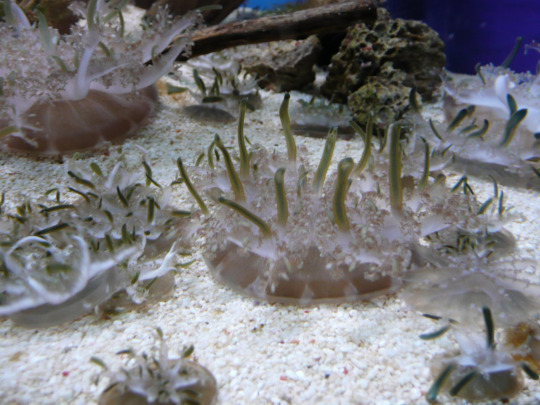
(image: multiple upside-down jellyfish lying on sand. They are ov various sizes and mostly light brown, but have thicker, green tentacles sticking op)
Upside-down jellyfish are found in warm coastal waters in Florida and the Caribbean and in Micronesia, Melanesia, and parts of Polynesia. They require shallow waters to allow enough light to reach their zooxanthellae and are usually found on shady or muddy bottoms. They are highly associated with mangroves and may play an important role in the mangrove habitats by mixing the water to recirculate oxygen and nutrients. They are rarely found alone, instead congregating in large groups that can cover portions of the seafloor. They attach by using their bells as suction cups and rhythmically pulse using the edges of the bell. This pulsing forces water over the gills and can force zooplankton into the stinging cells to become food. Stung prey will fall on the oral tentacles, where it is broken down into fragments that are then intaken through the numerous tiny oral openings on the tentacles. Interestingly, some species have cycles of reduced movement, which is believed to be the first known example of sleep in an animal without a central nervous system. While upside-down jellies can swim, they will usually only do so to escape predators or if their environment becomes unsuitable.
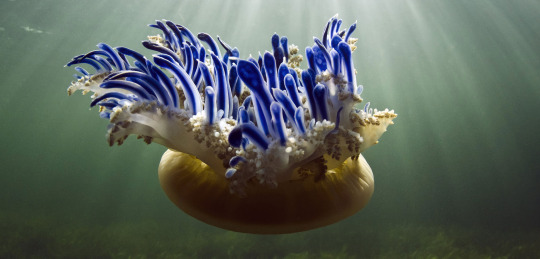
(image: an upside-down jellyfish swimming. The majority of its body is light brown, but it has many tentacles that are dark blue and outlined in white)
While a very neat thing to see underwater, many snorkelers avoid upside-down jellyfish due to a phenomenon called stinging water. This is when people will receive the symptoms of a sting by the jellyfish without actually touching it. While the cause of this was a mystery for a long time, it was solved when a 2020 paper was published in Communications Biology by Ames et al. The scientists discovered that upside-down jellies release clumps of mucus into the water. This mucus is filled with zooxanthellae and stinging cells and many of these clumps also have ciliated cells that allow for limited swimming. These clumps, named cassiosomes, are the source of the stinging water. The paper, titled "cassiosomes are stinging-cell structures in the mucus of the upside-down jellyfish Cassiopea xamachana" speculated that the cassiosomes are used for defense and feeding. The cassiosomes could be released to sting a potential predator from a distance, discouraging it from approaching the jellyfish. Presumably snorkelers trigger this defense when they swim over the jellies, resulting in stinging water. They could also be used to catch prey as zooplankton killed by the stinging cells would have a high likelihood of falling onto the jelly that released them. Because the cassiosomes have zooanthellae in them, they could survive for likely up to several days after release.

(image: a microscope image of three cassiosomes. They are irregularly-shaped blobs somewhat similar to popcorn. They are a dark color with grey outlines. Spots of green algae and white stinging cells dot their surface)
Upside-down jellyfish are threatened by habitat loss as many mangrove forests are torn down for development. They are also threatened by pollution. They are not considered dangerous to humans. The sting of an upside-down jellyfish can result in mild to severe rashes and itching, but is not lethal.
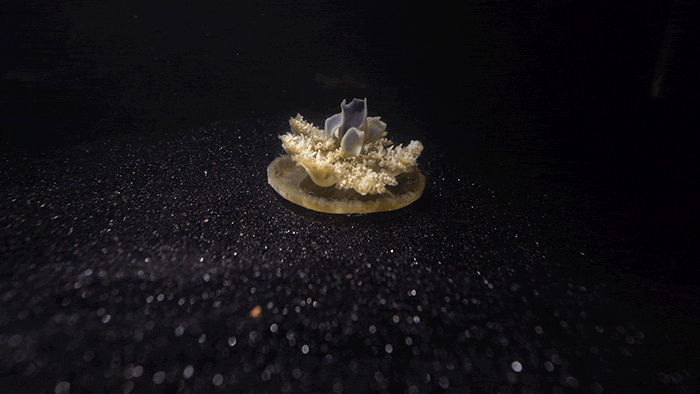
(gif: a lone, light brown upside-down jellyfish on black sediment. The edge of its flat, circular bell regularly pulse upward to move air over its gills and tentacles. This one's pulsing has slowed, which is speculated to be the result of it going through its sleep cycle)
#wet beast wednesday#upside down jellyfish#inverted invertebrate#marine biology#biology#zoology#ecology#animal facts#jellyfish#cnidarians#invertebrate
835 notes
·
View notes
Text
Overview of my blog
Hi, I see you've found my blog, must have been quite the journey huh. Nice to have you here! My name is Francesca Gelang Chong and I will be posting five interesting aspects about the tropical marine ecosystems – their quirks, what makes them special, and how they are being protected (starting from my next post ❗). I've listed down topics that have peaked my interest hehe so come along with me as we dive into Tropical Eco-logics.

𓈒ㅤׂㅤ𓇼 ࣪ 𓈒ㅤׂㅤ⭒
𓆡 ⭒ㅤ𓈒ㅤׂ 🫧
First entry: Introduction to Tropical Marine Ecosystems
- What is their importance as biodiversity/global ecology?
- The special properties and characteristics of tropical marine areas.
Second entry: Coral Reefs — Rainforests of the Sea
- The significance of coral reefs for tropical marine environments.
- The amazing levels of BIODIVERSITY found in coral reefs.
- Threats faced by coral reefs like coral bleaching and ocean acidification etc.
Third entry: Mangroves - Coastal Guardians
- The mangrove systems and what they do for coastlines.
- Ecological roles mangroves play in providing breeding homes for marine species and also as protection against coastal erosion.
- Conservation activities to preserve mangrove habitats.
Fourth entry: Seagrass Meadows — The Secret Gems of the Sea Floor
- What are seagrass meadows & what is their importance to our ecology?
- The role of seagrass in carbon sequestration and oxygen production.
- How vulnerable seagrass is to threats and why we need to conserve them.
Fifth entry: Marine Conservation and Sustainable Practices
- The significance of coastal conservation in the tropics.
- Campaigns and organizations pushing for preserving tropical marine habitats.
7 notes
·
View notes
Text
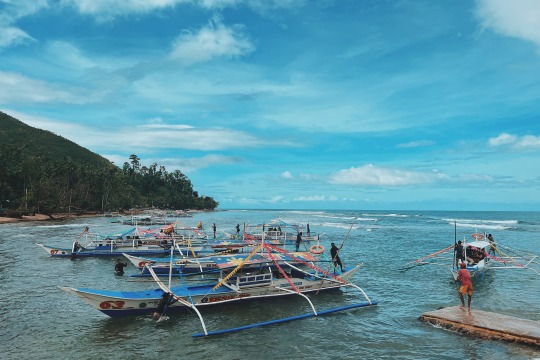



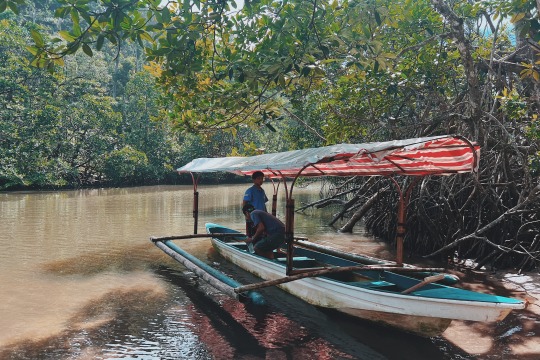




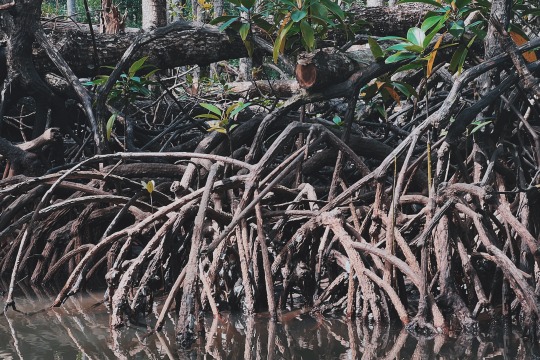



Sabang Village is pleasantly situated in Bry. Cabayugan in Puerto Princesa, and is best known as the jumping-off point of the Puerto Princesa Underground River in St.Paul's Bay. While most tourists often leave Sabang immediately after the underground river tour, there's more to this quiet village. Adding up to its raw appeal is the bountiful Sabang Mangrove Forest hidden nearby.
Sabang Mangrove Forest is one of the eco-tourism destinations in Puerto Princesa. Like any other mangrove forests in the world, it plays an important role in our biodiversity; serving as nutrient-rich habitats and breeding grounds for a variety of birds, snakes, monkeys, reptiles, fish, crabs, and other marine organisms. Another importance of mangrove forest is its climate resilience, as the mangrove roots above the ground slow down water flows and encourage sediments deposits thereby helping prevent erosion. Their roots also filter pollutants in the coastal waters, and they protect coastal communities during typhoons by absorbing storm surges and flooding.
In order to further protect the Mangrove Forest, the Sabang Mangove Forest Paddle Boat Tour was founded to empower local communities, provide additional income to residents, foster environmental awareness, and provide sustainable tourism activity that minimizes negative impact to the environment.



After our Sabang Mangrove Tour, our boatman excitedly showed us how to get the famous Puerto Princesa delicacy called tamilok (woodworm). It's actually a species of salt water clam called Teredoi navalis, nicknamed naval shipworm because it makes its way to the wood. Tamilok in the Philippines thrive on mangroves, mostly found on dead submerged mangrove trees. Our boatmen split the rotten wood open, and carefully examined the creases of the wood to look for tamilok. Then, they cleaned it with saltwater before finally cleaning it with tap water. Tamilok is typically served like kinilaw (ceviche). It is cured in vinegar, salt, lime juice, and chili, then, you can swallow it whole.
Seeing the tamilok prepared raw from the opening of the deadwood to the cleaning and curing is truly a unique experience. They look weird, but trust me, they are delicious!
6 notes
·
View notes
Text
Poonamben Maadam’s Roadmap to Economic Improvement

Jamnagar is a vibrant city nestled along the pristine coastline of Gujarat. It has now emerged as a budding tourist destination, thanks to the contributions of Poonamben Maadam, a member of the Bhartiya Janta Party (BJP), and her leadership. Poonamben Maadam's efforts to promote tourism in Jamnagar through the development of transportation and infrastructure have not only enriched the cultural tapestry of the region but have also contributed significantly to Gujarat's GDP.
Contribution of Jamnagar to Gujarat's GDP:
Jamnagar is renowned for its rich cultural heritage, stunning landscapes, and architectural marvels and thus has the potential to play a pivotal role in driving Gujarat's economic growth. The city's strategic location, coupled with its burgeoning industries and thriving tourism sector, has made it a key contributor to the state's GDP. With its bustling ports, flourishing businesses, and infrastructure, Jamnagar serves as an economic powerhouse, attracting investments and fostering prosperity.
Poonamben Maadam's Role in Developing Tourism:
Poonamben Maadam has been instrumental in harnessing the tourism potential of the region. Recognizing the allure of Jamnagar's natural beauty and cultural heritage, she has tried to showcase the city's splendor to the world. Through her initiatives and policies, Poonamben Maadam has succeeded in positioning Jamnagar as a tourist destination in Gujarat.
Promotion of Cultural Heritage and Infrastructure:
Poonamben Maadam's unwavering commitment to preserving and promoting Jamnagar's cultural heritage has been a cornerstone of her tourism development strategy. Her initiatives to restore ancient monuments, heritage sites, museums, and the development of overall transportation and increase connectivity offer visitors a glimpse into the city's glorious past. By organizing cultural festivals, exhibitions, and heritage walks, Poonamben Maadam has breathed new life into Jamnagar's cultural landscape, attracting tourists from far and wide.
Under her leadership, Jamnagar has witnessed significant investments in the development of transportation networks, accommodation facilities, and recreational amenities. The modernisation of airports, construction of hotels and resorts, and improvement of road connectivity have made Jamnagar more accessible and tourist-friendly.
Ecotourism and Sustainable Development:
Poonamben Maadam's commitment to sustainable tourism practices has been evident in her emphasis on ecotourism and environmental conservation. Recognizing the ecological significance of Jamnagar's tourism has also made use of its coastal ecosystems, she has advocated for the protection of mangroves, coral reefs, and marine life. Through ecotourism initiatives such as nature trails, birdwatching tours, and marine conservation programs, Poonamben Maadam has promoted responsible tourism while doing her best to safeguard the natural environment.
Future Prospects of Jamnagar’s Tourism:
As Jamnagar continues to evolve as one of the most sought-after tourist destinations, the future looks promising. With ongoing efforts to diversify tourism offerings, improve infrastructure, and uphold sustainable practices, Jamnagar is poised to attract a growing number of visitors and contribute even more significantly to Gujarat's GDP. Poonamben Maadam’s steadfast dedication to unlocking Jamnaga’'s tourism potential ensures that the city will shine bright on India’s tourism map for years to come.
Poonamben Maadam's vision and leadership have been instrumental in positioning Jamnagar as a great tourist destination in Gujarat. Through her strategic initiatives, promotion of cultural heritage, and commitment to sustainable development, she has transformed Jamnagar into a tourism hub, while also strengthening her constituency’s economic progress.
0 notes
Text

Mangrove forests are indeed fascinating coastal ecosystems that flourish in tropical and subtropical regions worldwide. What sets them apart is their remarkable ability to thrive in the challenging conditions of the intertidal zone, where the ebb and flow of tides bring together land and sea. These ecosystems boast a unique array of plant species, including salt-tolerant trees, shrubs, and other vegetation specially adapted to withstand the harsh and dynamic environment of coastal areas.
The presence of mangroves is characterized by their distinctive root systems, which often protrude above the water's surface or extend below the muddy substrate. These roots not only provide structural support for the mangrove trees but also serve a crucial role in nutrient uptake and stabilizing the surrounding sediment. Additionally, they create a complex network that offers refuge and breeding grounds for various marine organisms.
Mangrove forests play a multitude of vital ecological roles. They act as natural buffers against coastal erosion and storm surges, helping to protect shorelines from the destructive impacts of waves and currents. Their dense vegetation also serves as a habitat and food source for a diverse range of wildlife, including fish, crustaceans, birds, and mammals. Moreover, mangroves contribute to the overall health of coastal ecosystems by filtering pollutants, trapping sediment, and cycling nutrients.
Furthermore, mangrove forests are invaluable in mitigating climate change. They are exceptionally efficient at sequestering carbon dioxide from the atmosphere and storing it in their biomass and sediments. As such, they play a crucial role in helping to reduce greenhouse gas concentrations and mitigate the impacts of global warming.
In essence, mangrove forests represent a fascinating intersection of land and sea, where unique adaptations allow life to thrive in an otherwise challenging environment. Their ecological importance cannot be overstated, as they provide numerous benefits to both the environment and human communities. Protecting and conserving mangrove ecosystems is essential not only for the preservation of biodiversity but also for the resilience and sustainability of coastal regions worldwide.
0 notes
Text
Mangroves Forests: Nature's Green Barrier Against Climate Change

Absolutely! Mangrove forests are indeed nature's green barrier against climate change. These unique ecosystems, found in tropical and subtropical regions, provide a multitude of ecological and environmental benefits, making them invaluable in the fight against climate change. Here's how:
Carbon Sequestration: Mangroves are incredibly efficient at storing carbon dioxide. Despite covering only a small fraction of the Earth's surface, mangroves sequester carbon at a rate two to four times greater than tropical forests. Their dense organic matter, including roots and sediments, traps and stores carbon, helping to mitigate the effects of greenhouse gas emissions.
Coastal Protection: Mangrove forests act as natural buffers against storm surges, tidal waves, and hurricanes. Their intricate root systems stabilize coastal soils, reducing erosion and protecting coastal communities from the impacts of extreme weather events. In areas prone to tsunamis, mangroves have been known to significantly reduce wave heights, minimizing damage to nearby settlements.
Biodiversity Hotspots: Mangrove ecosystems support a diverse array of plant and animal species, many of which are specially adapted to the unique conditions found in these environments. They serve as vital habitats for various marine and terrestrial species, including fish, crustaceans, birds, and mammals. Protecting mangroves helps preserve biodiversity and ensures the survival of countless species.
Fisheries and Livelihoods: Mangrove forests are essential for coastal fisheries, providing breeding grounds, nurseries, and habitat for numerous commercially important fish and shellfish species. Millions of people depend on these fisheries for their livelihoods and sustenance. Preserving mangroves supports local economies and helps secure food security for coastal communities.
Water Filtration and Nutrient Cycling: Mangroves play a crucial role in filtering pollutants and improving water quality. Their root systems trap sediment and absorb excess nutrients, helping to prevent pollution runoff from reaching coastal waters. Additionally, mangroves facilitate nutrient cycling, enriching surrounding ecosystems and supporting marine life.
Climate Resilience: By mitigating the impacts of climate change, such as coastal erosion, flooding, and habitat loss, mangrove forests enhance the resilience of both natural and human communities. They contribute to climate adaptation strategies by providing sustainable solutions for coastal protection and ecosystem restoration.
Given their numerous ecological and socio-economic benefits, conserving and restoring mangrove forests is essential for combating climate change and promoting sustainable development. Efforts to protect mangroves should be integrated into broader conservation initiatives and climate action plans to ensure the long-term health and resilience of these invaluable ecosystems.

0 notes
Text
Why Sundarban Is the Best Destination for Eco-Tourists.
**Index:**
1. Introduction
2. Sundarban: A Biodiversity Hotspot
- Unique Flora and Fauna
- Royal Bengal Tiger: Icon of the Sundarbans
3. Conservation Efforts in the Sundarbans
- Mangrove Protection
- Wildlife Preservation
- Community Engagement
4. Eco-Tourism in the Sundarbans
- Sustainable Tourism Practices
- Ethical Wildlife Viewing
- Supporting Local Communities
5. Why Eco-Conscious Travelers Should Visit the Sundarbans
- Immersive Nature Experience
- Contribution to Conservation
- Cultural Exchange
6. Conclusion
---
1. Introduction
The Sundarbans, a UNESCO World Heritage Site located at the delta of the Ganges, Brahmaputra, and Meghna rivers, is not only a paradise for nature enthusiasts but also a haven for eco-tourists. In this guide, we'll explore why Sundarban stands out as the best destination for travelers seeking sustainable and environmentally-friendly experiences.
2. Sundarban: A Biodiversity Hotspot
**Unique Flora and Fauna:** The Sundarbans is renowned for its rich biodiversity, boasting a diverse array of plant and animal species adapted to its unique mangrove ecosystem. From towering Sundari trees to elusive Estuarine crocodiles, the Sundarbans offers a glimpse into nature's wonders.
**Royal Bengal Tiger: Icon of the Sundarbans:** One of the most iconic residents of the Sundarbans is the Royal Bengal Tiger. Adapted to the mangrove environment, these majestic predators roam the dense forests, making the Sundarbans the only place on earth where tigers swim.
3. Conservation Efforts in the Sundarbans
**Mangrove Protection:** The Sundarbans plays a crucial role in protecting coastal areas from erosion and cyclones. Efforts to conserve and restore mangrove forests are underway to safeguard this vital ecosystem and mitigate the effects of climate change.
**Wildlife Preservation:** Conservation initiatives in the Sundarbans focus on protecting endangered species such as the Royal Bengal Tiger, Irrawaddy dolphins, and Olive Ridley turtles. Measures such as anti-poaching patrols and habitat restoration aim to ensure the long-term survival of these species.
**Community Engagement:** Conservation efforts in the Sundarbans involve local communities, empowering them to become stewards of their environment. Community-based ecotourism initiatives provide sustainable livelihoods while promoting environmental awareness and conservation.
4. Eco-Tourism in the Sundarbans
**Sustainable Tourism Practices:** Eco-tourism operators in the Sundarbans adhere to sustainable practices, minimizing their environmental footprint while maximizing the benefits to local communities. Responsible waste management, energy conservation, and eco-friendly transportation are integral to their operations.
**Ethical Wildlife Viewing:** Eco-conscious travelers can enjoy ethical wildlife viewing experiences in the Sundarbans, guided by trained naturalists who prioritize the well-being of wildlife. Boat safaris and guided treks offer opportunities to observe wildlife in their natural habitat without causing disturbance.
**Supporting Local Communities:** Eco-tourism in the Sundarbans contributes to the socio-economic development of local communities by providing employment opportunities, supporting small businesses, and investing in community infrastructure projects. Travelers can directly support these efforts by choosing eco-friendly tour operators and purchasing locally-made handicrafts.
5. Why Eco-Conscious Travelers Should Visit the Sundarbans
**Immersive Nature Experience:** Visiting the Sundarbans offers eco-conscious travelers a chance to reconnect with nature in its purest form. Whether exploring dense mangrove forests, spotting rare bird species, or witnessing breathtaking sunsets over the river, the Sundarbans promises unforgettable experiences for nature lovers.
**Contribution to Conservation:** By visiting the Sundarbans, eco-conscious travelers directly contribute to conservation efforts aimed at protecting this fragile ecosystem and its inhabitants. Revenue generated from ecotourism supports conservation projects, research initiatives, and community development programs, ensuring the long-term sustainability of the Sundarbans.
**Cultural Exchange:** In addition to its natural wonders, the Sundarbans offers opportunities for cultural exchange with local communities. Travelers can immerse themselves in the vibrant culture of the Sundarbans, participating in traditional dances, sampling local cuisine, and learning about the rich history and folklore of the region.
6. Conclusion
The Sundarbans exemplifies the perfect blend of natural beauty, biodiversity, and conservation efforts, making it an ideal destination for eco-conscious travelers. By choosing to visit the Sundarbans, travelers not only have the opportunity to experience the wonders of this unique ecosystem but also play a vital role in its preservation for future generations.
0 notes
Text
Exploring Mumbai's Coastal Biodiversity: Preserving Marine Life
Introduction: Unveiling Mumbai's Coastal Wonders
In the bustling metropolis of Mumbai lies a hidden gem that often goes unnoticed amidst the urban chaos - its breathtaking coastal biodiversity. From the Arabian Sea gently caressing the shores to the vibrant marine life thriving beneath the waves, Mumbai's coastline is a testament to the marvels of nature.
The Rich Diversity of Marine Life
Coral Reefs: Nature's Underwater Cities
Mumbai's coastal waters are home to an extensive network of coral reefs. These intricate ecosystems provide shelter and sustenance to a myriad of marine species, from colorful fish to majestic sea turtles. Mumbai's coral reefs serve as vital breeding grounds, contributing to the overall health of the marine ecosystem.
Mangrove Forests: Guardians of the Coastline
Nestled along Mumbai's shores are dense mangrove forests, acting as natural barriers against coastal erosion and safeguarding against the wrath of tropical storms. These lush green havens are teeming with life, offering refuge to numerous species of birds, crabs, and other wildlife.
Marine Fauna: A Symphony of Life
Beneath the azure waters of the Arabian Sea lies a world teeming with biodiversity. Mumbai's coastal waters are inhabited by an array of marine fauna, including dolphins, whales, sharks, and rays. These magnificent creatures contribute to the ecological balance of the ocean, playing crucial roles in the food chain and ecosystem dynamics.
Conservation Efforts: Preserving Mumbai's Coastal Heritage
Sustainable Tourism Practices
As Mumbai's popularity as a tourist destination continues to soar, it's imperative to implement sustainable tourism practices to minimize the impact on the delicate coastal ecosystem. Eco-friendly initiatives such as responsible boating tours and educational marine expeditions can help raise awareness about the importance of conserving marine life.
Community Engagement and Education
Empowering local communities to become stewards of their coastal environment is key to long-term conservation efforts. By educating residents about the significance of preserving marine biodiversity and involving them in coastal clean-up drives and tree planting initiatives, we can foster a sense of ownership and pride in Mumbai's natural heritage.
Interrelation with Mumbai Pune Car Rental Services
Amidst the buzz of urban life, many residents and tourists alike seek respite in the tranquility of Mumbai's coastal retreats. However, navigating the bustling streets of Mumbai and venturing to nearby destinations such as Pune can be daunting. This is where Mumbai Pune car rental services come into play, offering convenient and hassle-free transportation options for travelers looking to explore the region.
Whether it's a weekend getaway to Pune's lush hills or a leisurely drive along Mumbai's picturesque coastline, Mumbai Pune car rental services provide the flexibility and freedom to experience the beauty of both cities. By opting for eco-friendly and fuel-efficient vehicles, travelers can minimize their carbon footprint and contribute to sustainable travel practices.
Conclusion: Embracing Mumbai's Coastal Heritage
In conclusion, Mumbai's coastal biodiversity is a treasure trove of natural wonders that deserves to be cherished and protected for generations to come. Through collaborative conservation efforts, sustainable tourism practices, and community engagement, we can ensure that Mumbai's marine life continues to thrive against the backdrop of urban development.
0 notes
Text
What Are Carbon Stocks In India?

In the context of environmental conservation and climate change mitigation, the term "carbon stocks" refers to the amount of carbon stored in various ecosystems such as forests, grasslands, and wetlands. These stocks are crucial in the global effort to reduce greenhouse gas emissions and combat climate change.
In India, carbon stocks are primarily associated with its diverse ecosystems, including forests, which play a significant role in sequestering carbon dioxide from the atmosphere. Here are some key aspects of carbon stocks in India:
Forests:
India is home to a variety of forest types, ranging from tropical and subtropical forests to temperate and alpine forests. These ecosystems act as significant carbon sinks, capturing and storing carbon through the process of photosynthesis. The amount of carbon stored in Indian forests contributes to the country's carbon stock.
Mangroves:
Mangroves, found along India's coastlines, are crucial carbon stores. These ecosystems sequester carbon in their biomass and soil, playing a role in coastal protection as well.
Grasslands and Wetlands:
Grasslands and wetlands also contribute to carbon stocks. These ecosystems store carbon in their vegetation and soil, and their conservation is essential for maintaining overall carbon balance.
Agricultural Soils:
The carbon content in agricultural soils is another component of carbon stocks. Sustainable agricultural practices can enhance soil carbon sequestration.
Conservation Efforts:
India has been making efforts to enhance its carbon stocks through afforestation, reforestation, and sustainable land management practices. Initiatives like the Green India Mission and the National Mission for Sustainable Agriculture aim to increase the carbon sequestration potential of various ecosystems.
Carbon Trading and REDD+ Programs:
India has also been exploring mechanisms such as carbon trading and participating in programs like Reducing Emissions from Deforestation and Forest Degradation (REDD+). These initiatives aim to provide financial incentives for developing countries to reduce emissions from deforestation and degradation and enhance carbon stocks.
One of the best way to start studying the stock market to Join India’s best comunity classes Investing daddy invented by Dr. Vinay prakash tiwari . The Governor of Rajasthan, the Honourable Sri Kalraj Mishra, presented Dr. Vinay Prakash Tiwari with an appreciation for creating the LTP Calculator.
LTP Calculator the best trading application in india.

You can also downloadLTP Calculator app by clicking on download button.

Monitoring and managing carbon stocks are integral components of India's climate change mitigation and adaptation strategies. By preserving and restoring ecosystems, particularly forests, the country aims to contribute to the global effort of mitigating climate change and ensuring environmental sustainability.
0 notes
Text
Unveiling the Secrets of Life Below Water: Goal 14 for a Sustainable Future
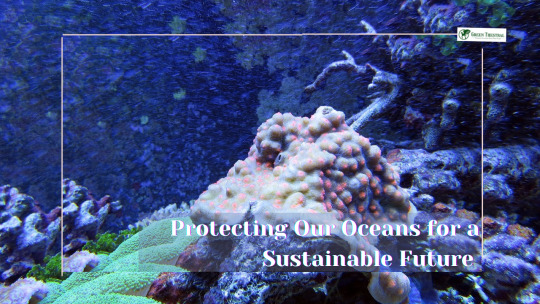
In our journey towards achieving a sustainable future, Goal 14 of the United Nations' Sustainable Development Goals (SDGs) plays a pivotal role. Life Below Water, as it is commonly referred to, focuses on the preservation and sustainable use of oceans, seas, and marine resources. With this goal, the international community aims to safeguard marine ecosystems, mitigate the impacts of human activities, and promote sustainable livelihoods for coastal communities. This article delves into the significance of Goal 14, explores the challenges faced, and highlights the initiatives that can help us ensure a healthier and more vibrant life below water.
Understanding the Importance of Goal 14
The Earth's oceans are vast and cover more than 70% of the planet's surface. They are teeming with life and harbor a remarkable diversity of species and ecosystems. From the mesmerizing coral reefs to the mysterious depths of the abyss, the oceans are a treasure trove of biodiversity, supporting millions of species, including plants, animals, and microorganisms.
Beyond their ecological significance, the oceans play a crucial role in regulating the Earth's climate. They act as a massive heat sink, absorbing a significant amount of the sun's energy and distributing it across the planet. Additionally, oceans play a vital role in the water cycle, facilitating the evaporation of water, which then falls as precipitation and sustains terrestrial ecosystems.
The oceans are not only important for the environment but also for human societies. They provide sustenance to millions of people around the world. Fishing, both for subsistence and commercial purposes, is a primary source of livelihood for coastal communities. The oceans also support economic activities such as tourism, shipping, and offshore industries, contributing significantly to global economies.
However, the delicate balance of marine ecosystems is under threat due to various human activities. Overfishing, driven by unsustainable practices and the demand for seafood, has led to the depletion of fish stocks worldwide. Large-scale industrial fishing, with destructive methods such as bottom trawling, threatens not only the targeted species but also the entire marine food web.
Marine pollution is another significant challenge faced by the oceans. Pollution from land-based sources, including plastic waste, chemicals, oil spills, and agricultural runoff, finds its way into the marine environment, causing severe harm to marine life and ecosystems. The accumulation of plastic debris in the oceans has reached alarming levels, forming giant garbage patches and causing entanglement and ingestion by marine organisms.
Habitat destruction and degradation are also taking a toll on marine ecosystems. Destructive practices such as coral reef destruction, coastal development, and the destruction of mangroves and seagrass beds result in the loss of critical habitats and the disruption of delicate ecological relationships. These habitats serve as nurseries and breeding grounds for many species, and their loss has far-reaching consequences for marine biodiversity.
Furthermore, climate change poses one of the most significant threats to life below water. Rising sea temperatures, ocean acidification, and sea-level rise are already impacting marine ecosystems. Corals, which are vital for the survival of countless marine species, are particularly vulnerable to rising temperatures and increased ocean acidity, leading to coral bleaching events and the degradation of coral reefs.
In recognition of the urgent need to protect and sustainably manage marine resources, Goal 14 of the United Nations' Sustainable Development Goals (SDGs) was established. Also known as Life Below Water, this goal aims to ensure the conservation and sustainable use of the oceans, seas, and marine resources for present and future generations.
Goal 14 encompasses various targets and indicators to guide efforts towards sustainable ocean management. One of the key focuses is the protection and restoration of coral reefs, which are among the most diverse and valuable ecosystems on Earth. Coral reefs provide habitat for numerous species, protect coastlines from erosion, and support vibrant tourism industries. By implementing measures to reduce coral bleaching, enhance reef resilience, and combat destructive practices, Goal 14 seeks to safeguard these vital ecosystems.
Another critical aspect of Goal 14 is the reduction of marine pollution. It calls for the prevention and significant reduction of marine debris, particularly plastic waste. Efforts are being made to promote better waste management systems, recycling and reusing plastics, and raising awareness about the detrimental effects of single-use plastics. Innovative technologies for ocean cleanup are also being developed to tackle existing pollution.
To address the issue of overfishing, Goal 14 emphasizes the need to restore fish stocks to sustainable levels. This involves implementing science-based management plans, combating illegal, unreported, and unregulated fishing, and promoting responsible fishing practices. Creating marine protected areas and adopting ecosystem-based management approaches can help protect critical habitats and ensure the long-term viability of fisheries.
Furthermore, Goal 14 acknowledges the urgent need to address ocean acidification, which poses a grave risk to marine organisms. By reducing carbon dioxide emissions and taking steps to enhance the resilience of marine ecosystems, such as protecting mangroves and seagrass beds, this goal aims to mitigate the impacts of ocean acidification and ensure the survival of vulnerable species.
Achieving Goal 14 requires a collaborative effort from governments, businesses, civil society organizations, and individuals worldwide. International cooperation is crucial to strengthen governance frameworks, regulate resource exploitation, combat illegal fishing, and promote sustainable practices. By taking collective action and embracing sustainable approaches, we can secure a healthier and more vibrant future for life below water.
Challenges and Threats to Life Below Water
The life below water faces a multitude of challenges that require immediate attention and concerted efforts. Overfishing, driven by unsustainable practices and illegal, unreported, and unregulated fishing, has led to a decline in fish stocks worldwide. The loss of biodiversity affects not only marine ecosystems but also the communities that depend on them for food security and economic opportunities.
Marine pollution poses another significant threat. Plastic waste, chemicals, oil spills, and other pollutants contaminate the oceans, harming marine life and ecosystems. The accumulation of plastic debris, in particular, has gained global attention due to its devastating impact on marine organisms and the potential consequences for human health through the food chain.
Ocean acidification, caused by the absorption of excess carbon dioxide from the atmosphere, poses a grave risk to marine organisms such as corals, shellfish, and plankton. Acidic waters can hinder the growth and survival of these organisms, disrupting the entire marine food web and impacting the livelihoods of coastal communities.
Initiatives and Solutions for a Sustainable Life Below Water
Achieving Goal 14 requires a comprehensive approach involving governments, businesses, civil society, and individuals. Several initiatives and solutions have emerged to address the challenges faced by life below water:
Sustainable Fisheries Management: Implementing science-based management plans, promoting responsible fishing practices, and combating illegal fishing are crucial steps towards replenishing fish stocks and ensuring the long-term sustainability of fisheries. Tools like marine protected areas and ecosystem-based management help preserve critical habitats and protect biodiversity.
Marine Pollution Prevention: Reducing plastic pollution and other sources of marine debris is vital. This can be achieved through improved waste management systems, recycling and reusing plastics, and raising awareness about the consequences of single-use plastics. Additionally, promoting the use of biodegradable alternatives and supporting innovative technologies for ocean cleanup can help mitigate the impact of existing pollution.
Climate Change Mitigation and Adaptation: Addressing climate change is fundamental to preserving life below water. Transitioning to renewable energy sources, reducing greenhouse gas emissions, and promoting sustainable coastal development are essential steps in mitigating the impacts of climate change on marine ecosystems. Additionally, enhancing the resilience of coastal communities through measures such as mangrove restoration, coastal protection, and sustainable tourism can aid adaptation efforts.
International Cooperation and Governance: Collaboration among nations is crucial for the effective implementation of Goal 14. Strengthening international frameworks, such as the United Nations Convention on the Law of the Sea (UNCLOS), and promoting regional cooperation can help combat illegal fishing, regulate resource exploitation, and ensure the sustainable use of marine resources.
Conclusion
Preserving life below water is not only crucial for the health of our oceans but also for the overall well-being of our planet. Goal 14 provides a roadmap for sustainable ocean management, aiming to conserve marine biodiversity, mitigate pollution, and promote the sustainable use of marine resources. By taking action at individual, local, and global levels, we can make a significant difference in ensuring a healthier and more vibrant future for life below water. Let us join hands and work together to safeguard the oceans for generations to come.
#Sustainable management of marine resources#Conserving marine biodiversity#Protecting coral reefs and marine ecosystems#Sustainable fishing practices for life below water#Reducing marine pollution for a healthier ocean#Restoring fish stocks for sustainable fisheries#Addressing the threats of overfishing#Combating illegal fishing activities#Preserving the delicate balance of marine ecosystems#Tackling plastic pollution in the oceans#Solutions for ocean acidification#Climate change impact on life below water#Sustainable tourism and the oceans#Promoting responsible coastal development#Achieving United Nations' Goal 14 for a sustainable future#Enhancing resilience of coastal communities#Sustainable livelihoods for coastal populations#Importance of ocean conservation and sustainability#Preserving marine habitats and species diversity#Ecosystem-based management for marine resources#Strengthening international cooperation for Goal 14#Achieving sustainable development through Goal 14#Role of marine protected areas in conservation#Long-term viability of marine ecosystems#Promoting sustainable shipping practices#Economic benefits of sustainable ocean management#Balancing human activities with marine conservation#The significance of Goal 14 in the SDGs#Ensuring a vibrant future for life below water#Global initiatives for the protection of marine environments
2 notes
·
View notes
Text
Conservation Efforts and Marine Marvels: Protecting Turtles Gold Coast
Protecting the Precious: Conservation Efforts for Turtles Gold Coast
In recent years, the Gold Coast has emerged as a hotspot for marine conservation efforts, particularly in safeguarding the habitat of turtles. With its stunning coastline and rich biodiversity, this region serves as a critical nesting ground for various species of turtles, including the loggerhead, green, and hawksbill turtles.

Understanding the Importance of Turtles Gold Coast
Turtles play
a crucial role in maintaining the balance of marine ecosystems. As keystone species, they contribute to the health of coral reefs and seagrass beds by controlling the population of certain prey species and facilitating nutrient cycling. Moreover, turtles serve as indicators of ecosystem health, making their conservation essential for overall marine biodiversity.
Threats to Turtles Gold Coast
Despite their ecological significance, turtles face numerous threats in their natural habitat. Human activities such as coastal development, pollution, and climate change pose significant challenges to their survival. Coastal development disrupts nesting sites and foraging grounds, while pollution, including plastic debris and oil spills, can directly harm turtles through ingestion or entanglement. Additionally, rising temperatures and sea levels associated with climate change threaten nesting beaches and alter ocean currents, affecting the distribution of turtle populations.
Conservation Initiatives for Turtles Gold Coast
Recognizing the urgency of the situation, various organizations and government agencies have launched conservation initiatives to protect turtles on the Gold Coast. These efforts encompass a range of strategies, including habitat restoration, nest monitoring, and public education campaigns. By collaborating with local communities, stakeholders aim to raise awareness about the importance of turtle conservation and promote sustainable practices to mitigate threats.
Nest Monitoring and Protection
One of the primary conservation activities is the monitoring and protection of turtle nests along the coastline. Volunteers and researchers patrol nesting beaches during the nesting season to identify and protect nests from predation and human disturbance. Protective measures such as nest cages and relocation to safer areas help increase the survival rate of turtle hatchlings.
Habitat Restoration and Rehabilitation
Efforts to restore and rehabilitate turtle habitats are also underway to provide suitable nesting and foraging areas. Restoration projects focus on conserving coastal dunes, mangroves, and seagrass meadows, which are vital components of turtle ecosystems. By restoring degraded habitats, conservationists aim to enhance the resilience of turtle populations to environmental stressors.
Community Engagement and Education
Engaging local communities and raising awareness about turtle conservation are integral parts of conservation efforts on the Gold Coast. Educational programs, interactive workshops, and outreach events are organized to educate residents and visitors about the importance of protecting turtles and their habitats. By fostering a sense of stewardship and responsibility, these initiatives encourage individuals to adopt environmentally friendly practices and support turtle conservation efforts.
Conclusion: A Shared Responsibility
Protecting turtles on the Gold Coast requires collective action and commitment from all stakeholders, including government agencies, non-profit organizations, businesses, and the public. By implementing effective conservation strategies and promoting sustainable practices, we can ensure the long-term survival of turtle populations and preserve the unique marine ecosystem of the Gold Coast for future generations.
0 notes
Text
Riding the Wave of Ocean Heroes: Conservation & Sustainability
Hello lovelies ໒꒰ྀི´ ˘ ` ꒱ྀིა I hope you've been doing great since the last entry hehe. I just wanted to express my heartfelt gratitude to each and every one of you for your ongoing support and interaction with my weekly updates. This post will be my last (at least for a while). I really hope you've managed to pick up a thing or two from my blog. Thank you for being here, and I appreciate all of you (づ๑•ᴗ•๑)づ♡
Now, let's dive into something super cool today – marine conservation and how we can be kinder to our oceans.

Did you know?
Around half of the world's population lives within 100 kilometers of the coast.
That's a lot of people living near the sea, right?
Coastal places by the sea are like gold mines for our planet. They help out the global economy, and they do some pretty amazing stuff, like storing carbon (which is great for the environment), protecting our shores, and providing us with yummy food (Mcleod et al. 2011; Barbier et al. 2011).
You see, more than 775 million people really rely on the sea and its coastal wonders (Selig et al. 2018). For example, fish is a big deal, giving about 3.2 billion people some of their protein. It's even more crucial in places where people are still developing their countries (FOA 2018). Plus, it's not just food; it's like a vitamin boost in your meal. And, tons of people make a living out of fishing and farming seafood, almost 57 million of them! (FOA 2018).
Now, when we talk about tropical spots near the sea, they're like treasure chests. There are amazing places like coral reefs, mangroves, and seagrasses that are teeming with life, and they help out our planet in so many ways. That's why a bunch of groups and campaigns are working hard to keep these places safe and sound.
Let's focus into how people in Malaysia are doing for a sec. Here are some rock stars doing their part to save these coastal wonders:
ICRI (International Coral Reef Initiative) Malaysia: These people are all about creating safe spaces in the sea for our underwater buddies to thrive. Right now, only 1.4% of Malaysia's waters are protected. They're on a mission to change that!
The Dugong & Seagrass Conservation Project: This one's all about saving dugongs (those adorable sea cows) and the seagrass they munch on in the Bay of Brunei, Lawas, Sarawak East Malaysia. It's a big deal because these seagrasses need some protection from overfishing and other stuff that could hurt them. The locals are getting in on the action too.
Tropical Research and Conservation Centre: These ocean heroes are based in the Celebes Sea, and they're all about saving sea turtles and fixing up coral reefs that got bashed up by fish bombing practices in Malaysia. They're on a mission to keep our underwater world vibrant and healthy.
So, there you have it! These incredible peeps are working hard to make sure our oceans stay awesome. It's all about taking big steps and little steps, but together, we can keep those secret underwater gardens thriving 🌊⋆。°்⋆

Author's note: One of my all-time favorite YouTube channels recently released a new video that I believe is absolutely worth your time. His videos are like compelling stories paired with stunning cinematography. In this latest video, he highlights the alarming issue of the world's coral reefs deteriorating. It's crucial to shed light on real-world issues that are overlooked.
youtube

References:
Barbier, EB, Hacker, SD, Kennedy, C and Koch EW 2011, ‘The value of estuarine and coastal ecosystem services’, Ecological Monographs, vol. 81, no. 2, pp. 169 - 193.
FOA 2018, The state of world fisheries and aquaculture 2018 (SOFIA), Food and Agriculture Organization of the United Nations, Rome, Italy.
Mcleod, E, Chmura, GL, Bouillon, S, Salm, R, Bjork, M, Duarte, CM, Lovelock, CE, Schlesinger, WH and Silliman, BR 2011, ‘A blueprint for blue carbon: toward an improved understanding of the role of vegetated coastal habitats in sequestering CO2’, Frontiers in Ecology and the Envinronment, vol. 9, no. 10, pp. 552 - 560.
Selig, ER, Hole, DG, Allison, EH, Arkema, KK, McKinnon, MC, Chu, J, Sherbinin, Ad, Fisher, B, Glew, L, Holland, MB, Ingram, JC, Rao, NS, Russell, RB, Srebotnjak, T, Teh, LCL, Troeng, S, Turner, WR, and Zvoleff, A 2018, ‘Mapping global human dependence on marine ecosystems’, Conservation Letters, vol. 12, no. 2, p. E12617.
#Youtube#marine#conservation#ecology#environment#malaysia#sustainability#livelaughlovetheworld#hehe :3#science#tropical
4 notes
·
View notes
Text
What is the most important resource in the Sundarbans?
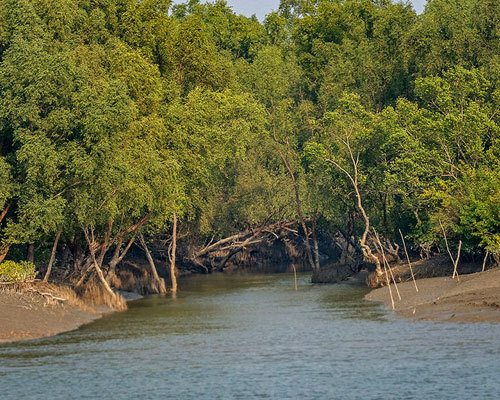
The Sundarbans, a UNESCO World Heritage Site that spans India and Bangladesh, is known for its dense mangrove forests, complicated network of waterways, and diverse animals. Among the countless beauties stored within this mysterious area, one resource stands out as the Sundarbans' lifeblood: the mangroves.Mangroves play a crucial role in maintaining the health and well-being of both the environment and humankind.
Understanding the Importance of Mangroves :
The dense forests are known as mangrove forests. They are created by a variety of woody plants and salt-tolerant trees that grow in coastal shoreline zones. These ecosystems succeed in the brackish waters where freshwater and saltwater mix. With their vast areas of mangrove forests, the Sundarbans are an ideal example of the essential role these ecosystems play in supporting life.
1. Biodiversity Hotspot:
The Sundarbans mangroves are home to an amazing variety of plant and animal species. It’s an important area for wildlife. Many rare and threatened species, such as the well-known Royal Bengal Tiger, estuarine crocodiles, Gangetic dolphins, and other fish, bird, and crab species, find refuge in these deep forests. Mangroves are vital to the survival of both local and migratory species. Because their complex root systems provide a haven and breeding grounds for countless marine and ground-living things.
2. Coastal Protection:
A Sundarban Tour Packages from Kolkata can show how mangroves protect inland areas from the damaging power of storms and tsunamis by acting as natural barriers against wave damage and waves from storms. The dense network of roots stabilizes the soil and evaporates wave energy. It helps to reduce the impact of extreme weather events on coastal communities. Mangroves act as a first line of defense in the Sundarbans, where storms can kill millions of people, protecting lives and livelihoods.
3. Carbon Sequestration:
Through photosynthesis and sand buildup, mangrove forests are incredibly powerful carbon sinks that may absorb significant volumes of carbon dioxide from the atmosphere. Long-term carbon storage in the soil occurs in mangroves due to the organic matter and thick vegetation that trap carbon. This improves soil fertility and stability, which increases the adaptability of marine ecosystems while simultaneously reducing the release of greenhouse gases and reducing climate change.
4. Livelihoods and Sustainable Development:
Local inhabitants depend on these ecosystems for fishing, crabbing, honey collection, and traditional medicine. Mangrove wood is also used for construction, fuel, and boat-making. In addition, ecotourism has grown into an attractive economic industry that provides funds while raising environmental awareness and protection.
Challenges and Conservation Efforts:
Mangrove forests are highly endangered by a variety of problems, such as logging, pollution, excessive harvesting, and climate change. Particularly in the Sundarbans, they face the twin threats of increasing sea levels and human meddling, which increase the ecosystem's instability. To solve these issues and preserve the Sundarbans for future generations, conservation initiatives are now in progress.
1. Protected Areas and Wildlife Conservation:
Both India and Bangladesh have established protected areas within the Sundarbans, such as the Sundarbans National Park and the Sundarbans Reserve Forest, to preserve their unique biodiversity and ecological integrity. In order to reduce conflicts between people and wildlife, these protected areas are maintained through programs including ecological restoration, anti-poaching patrols, and community-based conservation efforts.
2. Sustainable Development and Community Engagement:
Goals are being set to empower local communities to participate in conservation efforts and promote sustainable development practices. This includes projects focused on eco-friendly tourism, alternative livelihoods, capacity development, and educational activities.
0 notes
Text
Sowing Seeds of Sustainability: Mangrove Tree Planting and Kayaking in UAE
Introduction:
In the heart of the United Arab Emirates, nestled within the pristine mangrove forests of Abu Dhabi and Ajman, a unique outdoor team activity awaits those with a passion for nature and a commitment to environmental stewardship. This extraordinary experience combines the thrill of kayaking with the satisfaction of contributing to the planet’s well-being through mangrove tree planting
Connecting with Nature:
The adventure begins with an enlightening awareness session, setting the stage for a day filled with eco-friendly initiatives. Participants gather insights into the crucial role mangroves play in the ecosystem — acting as the roots of the sea. The significance of these resilient trees extends beyond aesthetics; they serve as vital contributors to coastal protection, carbon sequestration, and marine biodiversity.
Mangrove Tree Planting:
United by a common purpose, teams dive into the hands-on experience of planting young mangrove saplings. Under the guidance of environmental experts, participants learn the art of planting and nurturing these trees, ensuring their survival for generations to come. This activity fosters a sense of responsibility and teamwork as individuals work collectively to make a tangible impact on the environment.
As hands meet soil and saplings find their new home, the participants become active contributors to the preservation of coastal ecosystems. The act of planting mangroves becomes symbolic — a commitment to sustainable practices and a pledge to safeguard the delicate balance of nature.
Kayaking Through Mangrove Mysteries:
With the scent of newly planted saplings lingering in the air, the adventure seamlessly transitions into an exhilarating kayaking experience. A guided tour through the intricate mangrove channels provides a unique perspective on the diverse ecosystem. Paddling through serene waters surrounded by thriving mangrove forests, participants witness the harmonious coexistence of land and water.
The kayak adventure serves not only as a recreational activity but also as an educational journey. Knowledgeable guides share insights into the various mangrove species, local wildlife, and the interconnectedness of these ecosystems. The experience fosters a deep appreciation for the natural world and instills a sense of responsibility for its protection.
Team Building in Nature’s Classroom:
The combination of mangrove tree planting and kayaking creates an ideal setting for team building. The shared challenges of planting saplings and navigating through mangrove waterways encourage communication, cooperation, and problem-solving skills. Teams forge stronger bonds as they collectively contribute to a meaningful cause, transcending traditional team-building activities.
Amidst the tranquility of the mangroves, participants discover the power of collaboration and the positive impact their collective efforts can have on the environment. The shared experience becomes a lasting memory, fostering a sense of camaraderie that extends beyond the workplace.
Companies for Good: A Platform for Sustainable Initiatives
Amidst the beauty of the mangroves, there lies an opportunity to amplify the impact of such initiatives. Companies for Good, our dedicated platform, catalyzes corporate social responsibility. By connecting businesses with environmentally conscious activities, we facilitate the integration of sustainable practices into corporate culture.
Companies for Good partners with organizations to align their values with purposeful activities, promoting environmental consciousness, and fostering a sense of social responsibility among employees. Through our platform, businesses can discover and participate in events like mangrove tree planting and kayaking, creating a positive ripple effect within and beyond their organizational boundaries.
Conclusion:
Embarking on the journey of mangrove tree planting and kayaking in the UAE is not just an outdoor adventure; it’s a commitment to the planet’s well-being and a testament to the power of collective action. As participants paddle through the mangrove waterways and witness the growth of the trees they planted, they become stewards of nature, leaving a lasting legacy for future generations.
Companies for Good stands as a beacon, guiding organizations towards sustainable practices and impactful corporate social responsibility. Join us in this extraordinary experience, where the beauty of nature and the spirit of collaboration converge to create a lasting imprint on the environment and the hearts of those who embark on this remarkable journey.
0 notes
Text
Facing the Challenges of Climate Change in the Sundarbans

Spreading across Bangladesh and India, the Sundarban trip is a vast network of mangrove forests that serves as a natural barrier protecting sensitive coastal areas, a refuge for diverse wildlife, and a thriving socio-economic hub. However, a story of growing fears is whispered in this picturesque setting. The Sundarbans are threatened by climate change, an unrelenting spectre that threatens both the region's delicate balance and the livelihoods of its people.
Increasing sea levels, stronger cyclones, and unpredictable weather patterns are creating a tapestry of problems that need to be addressed right now. Through an examination of the environmental, social, and economic ramifications of climate change on Sundarban eco tourism, this piece showcases the resourcefulness and resiliency of the people who live in this exceptional habitat.
Focusing on the Sundarban Trip
Unveiling the Sundarbans: A Journey through the Realm of Tigers and Mangroves: This title captures the essence of the Sundarbans, highlighting its iconic wildlife and unique ecosystem.
Beyond the Boardwalks: Exploring the Sundarbans Off the Beaten Path: This title appeals to adventurous travellers seeking a deeper experience beyond the typical tourist routes.
Faces of the Sundarbans: Encounters with the People and Culture of the Delta: This title focuses on the human aspect of the Sundarbans, showcasing the lives and traditions of the local communities.
A Photographic Odyssey: Capturing the Beauty and Majesty of the Sundarbans: This title caters to photographers and nature lovers, highlighting the stunning visuals of the region.
Sustainable Sundarbans: A Sustainable Tourism Destination? Exploring the Challenges and Opportunities: This title tackles the critical issue of sustainable tourism in the region.
Focusing on Eco Tourism & Eco Village Resort
The Allure of Eco Tourism: Why Choose the Sundarbans for a Sustainable Adventure: This title explains the benefits of eco-tourism and how it can positively impact Sundarbans.
Responsible Travel in the Sundarbans: Tips for Minimizing Your Environmental Footprint: This title provides practical tips for travellers to minimize their impact on the delicate ecosystem.
Supporting Conservation through Travel: How Eco Tourism Contributes to Protecting the Sundarbans: This title highlights the role of eco tourism in supporting conservation efforts.
Eco-Friendly Accommodation in the Sundarbans: Choosing Sustainable Stays for Your Trip: This title focuses on showcasing eco-friendly lodging options for travellers.
Beyond Tiger Tourism: Exploring the Diverse Eco-Tourism Experiences of the Sundarban trip. This title broadens the scope of eco tourism beyond just tiger sightings, highlighting other attractions.
Focusing on Eco Village Resort
Harmony with Nature: Experiencing the Sundarbans from an Eco Village Resort: This title emphasizes the unique experience of staying in a resort that integrates with the natural environment.
Living Off the Land: Sustainable Practices at an Eco Village Resort in the Sundarban trip. This title delves into the specific sustainable practices implemented by the resort.
Community Connection: Supporting Local Villages through Eco Tourism at a Sundarbans Resort: This title highlights the positive impact the resort has on local communities.
Luxury with a Conscience: Eco-Friendly Indulgences at a Sundarbans Village Resort: This title targets travellers seeking a luxurious yet responsible travel experience.
From Eco Village to Eco Champion: How a Sundarbans Resort Inspires Sustainable Living: This title showcases the resort as a model for sustainable tourism practices.
Conclusion
The future of the Sundarban trip is precariously balancing between the unrelenting forces of climate change and the resolute nature of its people. A broad strategy is needed to address this catastrophe, including strong conservation efforts, community-driven adaptation plans, and international cooperation to stop climate change at its source. The Sundarbans serve as a reminder of the complex web of life that is perilously entwined; it is more than just a victim. We can guarantee that the Sundarbans remain a symphony of life.
A monument to the enduring power of nature, and a source of hope for future generations by accepting its predicament and our need to conserve it. Action must be taken immediately since the future of Sundarban eco tourism is closely connected to our own. Let's take on the challenge, protect this priceless planet jewel, and make sure that its colourful tapestry keeps working its charm for many years to come.
0 notes